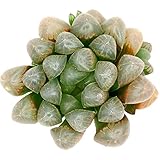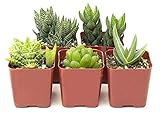The Best Haworthia Obtusa of 2023 – Reviewed and Top Rated
After hours researching and comparing all models on the market, we find out the Best Haworthia Obtusa of 2023. Check our ranking below.
2,364 Reviews Scanned
- LIGHT: Haworthia obtusa prefers bright, indirect sunlight. It will grow well in a south-facing window that gets at least 6 hours.
- SOIL: Choose a well-draining soil that's abundant in perlite, pumice, or coarse sand.
- WATER: Be very careful not to over water your Haworthia obtusa. If the plant has gone dormant during the summer, cut down on watering until it resumes normal growth.
- TALL: Less than 6 “in height as well as in diameter.
- USDA ZONE: Haworthia Obtusa 'Crystal' is suitable for cultivation in USDA zones 9 to 11.
- Haworthia cooperi var. obtusa is a type of translucent Haworthia. There are 20 to 25 per rosette, succulent soft and glassy (almost transparent) round-tipped somewhat spherical with lovely blue-green translucent-patterns. When receiving too much sun or not get enough water, the leaves will become reddish.
- Bright, indirect light, partial shade.
- Porous, well-drained potting mix with sand, pumice or decomposed granite.
- Water only when soil is dry to the touch. Let drain completely after each watering.
- Offsets (New plants are freely produced basally between the leaves)
- 『INCLUDES』 (1) Beautiful live Haworthia Cymbiformis VAR. Obtusa fully rooted.
- 『LIGHT』 Bright filtered light indoors or undercover outdoors.
- 『SOIL』Use a cactus mix or very fast-draining potting soil mixed with sand.
- 『USDA ZONE』From 10a: to -1.1 °C (30 °F) to 11: above 4.5 °C (40 °F).
- 『WATER』Average Water Needs, Water regularly, do not overwater.
- INCLUDED IN PURCHASE | (5) assorted haworthia succulents in 2" pot. Each plant may vary from pictures shown as plants are hand selected based on season, size, health, and readiness.
- WATERING NEEDS | Succulents are very sensitive to overwatering, and damp soil can cause root rot. Dry out soil completely between waterings. Recommended amount is once every two weeks. Tip: top inch of soil should feel dry before watering again.
- FERTILIZING NEEDS | Fertilize every two to four weeks during spring and summer. Withhold fertilizer during the fall and winter months.
- SOIL | SUN | POTTING | Use well-draining soil. Regular potting soil or dirt won't do. Use cactus soil/mix potting soil with sand/pumice/perlite. Approximately 6 hours of sun per day. Gradually give plant more sunlight each day.
- CUSTOMER ASSURANCE | We strive to provide the highest quality plants delivered. If plants arrive damaged or unhealthy, we will issue a full refund or replace your plant.
Last update on 2025-07-05 / Affiliate links / Product Titles, Images, Descriptions from Amazon Product Advertising API
How Do You Buy The Best Haworthia Obtusa?
Do you get stressed out thinking about shopping for a great Haworthia Obtusa? Do doubts keep creeping into your mind? We understand, because we’ve already gone through the whole process of researching Haworthia Obtusa, which is why we have assembled a comprehensive list of the greatest Haworthia Obtusa available in the current market. We’ve also come up with a list of questions that you probably have yourself.
We’ve done the best we can with our thoughts and recommendations, but it’s still crucial that you do thorough research on your own for Haworthia Obtusa that you consider buying. Your questions might include the following:
- Is it worth buying an Haworthia Obtusa?
- What benefits are there with buying an Haworthia Obtusa?
- What factors deserve consideration when shopping for an effective Haworthia Obtusa?
- Why is it crucial to invest in any Haworthia Obtusa, much less the best one?
- Which Haworthia Obtusa are good in the current market?
- Where can you find information like this about Haworthia Obtusa?
We’re convinced that you likely have far more questions than just these regarding Haworthia Obtusa, and the only real way to satisfy your need for knowledge is to get information from as many reputable online sources as you possibly can.
Potential sources can include buying guides for Haworthia Obtusa, rating websites, word-of-mouth testimonials, online forums, and product reviews. Thorough and mindful research is crucial to making sure you get your hands on the best-possible Haworthia Obtusa. Make sure that you are only using trustworthy and credible websites and sources.
We provide an Haworthia Obtusa buying guide, and the information is totally objective and authentic. We employ both AI and big data in proofreading the collected information. How did we create this buying guide? We did it using a custom-created selection of algorithms that lets us manifest a top-10 list of the best available Haworthia Obtusa currently available on the market.
This technology we use to assemble our list depends on a variety of factors, including but not limited to the following:
- Brand Value: Every brand of Haworthia Obtusa has a value all its own. Most brands offer some sort of unique selling proposition that’s supposed to bring something different to the table than their competitors.
- Features: What bells and whistles matter for an Haworthia Obtusa?
- Specifications: How powerful they are can be measured.
- Product Value: This simply is how much bang for the buck you get from your Haworthia Obtusa.
- Customer Ratings: Number ratings grade Haworthia Obtusa objectively.
- Customer Reviews: Closely related to ratings, these paragraphs give you first-hand and detailed information from real-world users about their Haworthia Obtusa.
- Product Quality: You don’t always get what you pay for with an Haworthia Obtusa, sometimes less, and sometimes more.
- Product Reliability: How sturdy and durable an Haworthia Obtusa is should be an indication of how long it will work out for you.
We always remember that maintaining Haworthia Obtusa information to stay current is a top priority, which is why we are constantly updating our websites. Learn more about us using online sources.
If you think that anything we present here regarding Haworthia Obtusa is irrelevant, incorrect, misleading, or erroneous, then please let us know promptly! We’re here for you all the time. Contact us here. Or You can read more about us to see our vision.
FAQ:
Q: What’s the difference between Haworthia cooperi and obtusa?
A: This variety is similar to Haworthia cooperi var. truncata, but it has a bit different leaf shape and less transparent leaf tips. The varietal epithet “obtusa” derives from the Latin “obtusus,” meaning “blunt or dull” and refers to the blunt apex of the leaves.
Q: What kind of plant is Haworthia umbraticola?
A: Haworthia cymbiformis var. umbraticola, Haworthia hilliana, Haworthia obtusa, Haworthia umbraticola, Haworthia umbraticola var. hilliana This variety is native to South Africa (Eastern Cape). Haworthia cymbiformis var. obtusa is a small succulent that forms rosettes of fleshy, smooth, bright green leaves.
Q: How big does a Haworthia cymbiformis rosette get?
A: Haworthia cymbiformis var. obtusa is a small succulent that forms rosettes of fleshy, smooth, bright green leaves. The rosettes grow up to 4 inches (10 cm) in diameter and offsets at their base to form large clumps. Leaves are boat-shaped with darker longitudinal stripes and transparent tips.





